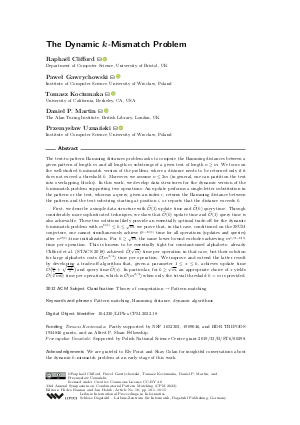@InProceedings{clifford_et_al:LIPIcs.CPM.2022.18,
author = {Clifford, Rapha\"{e}l and Gawrychowski, Pawe{\l} and Kociumaka, Tomasz and Martin, Daniel P. and Uzna\'{n}ski, Przemys{\l}aw},
title = {{The Dynamic k-Mismatch Problem}},
booktitle = {33rd Annual Symposium on Combinatorial Pattern Matching (CPM 2022)},
pages = {18:1--18:15},
series = {Leibniz International Proceedings in Informatics (LIPIcs)},
ISBN = {978-3-95977-234-1},
ISSN = {1868-8969},
year = {2022},
volume = {223},
editor = {Bannai, Hideo and Holub, Jan},
publisher = {Schloss Dagstuhl -- Leibniz-Zentrum f{\"u}r Informatik},
address = {Dagstuhl, Germany},
URL = {https://drops-dev.dagstuhl.de/entities/document/10.4230/LIPIcs.CPM.2022.18},
URN = {urn:nbn:de:0030-drops-161454},
doi = {10.4230/LIPIcs.CPM.2022.18},
annote = {Keywords: Pattern matching, Hamming distance, dynamic algorithms}
}

 Creative Commons Attribution 4.0 International license
Creative Commons Attribution 4.0 International license
